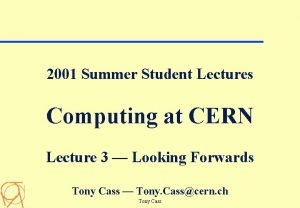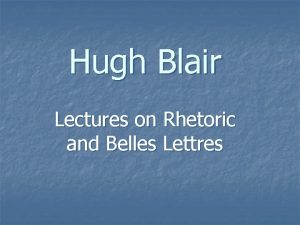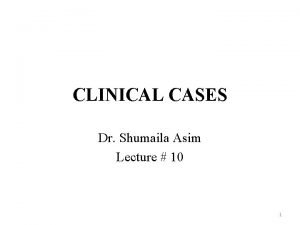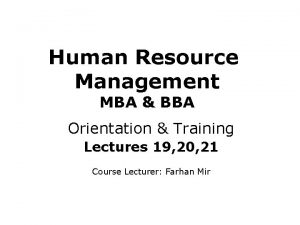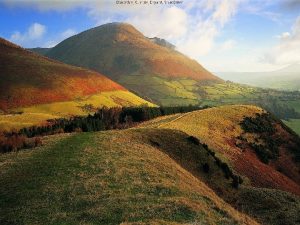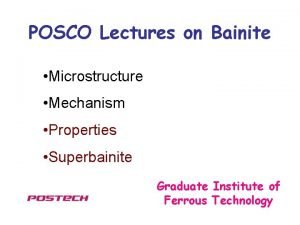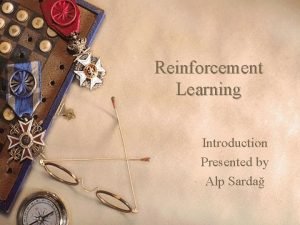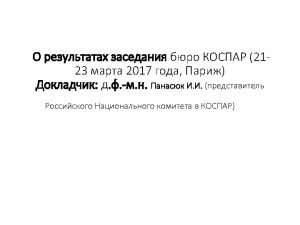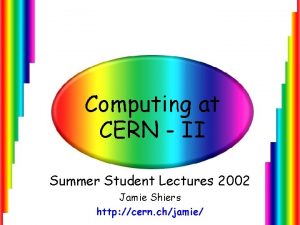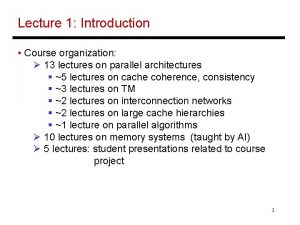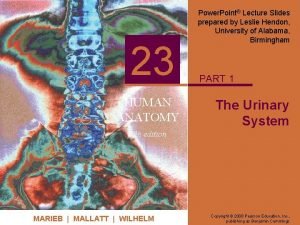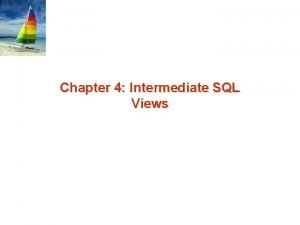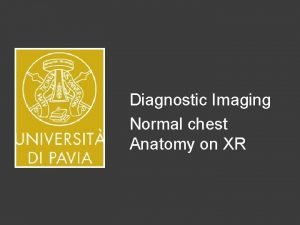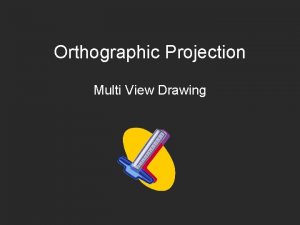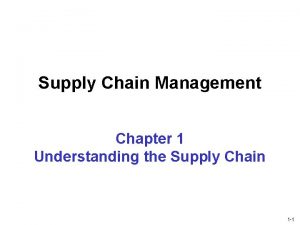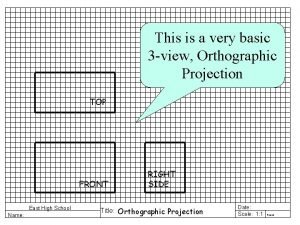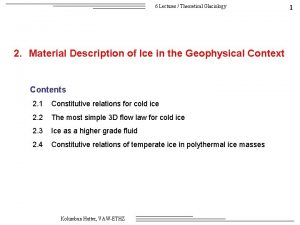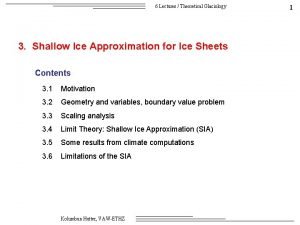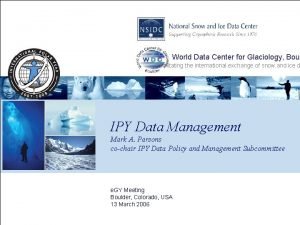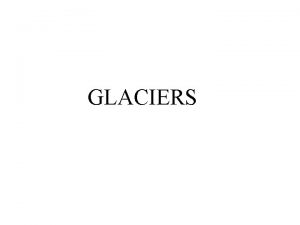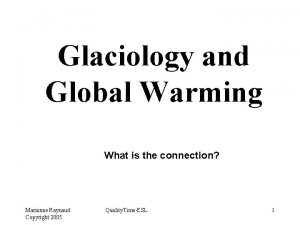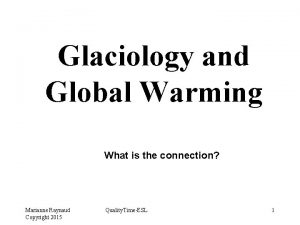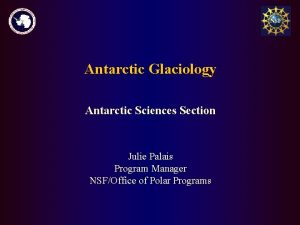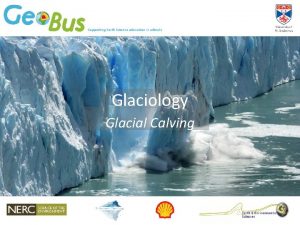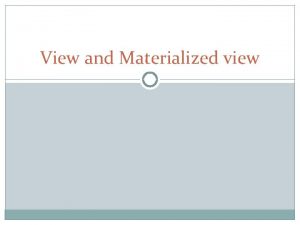6 Lectures Theoretical Glaciology 6 An integrated view






























































- Slides: 62

6 Lectures / Theoretical Glaciology 6. An integrated view of the role of ice in climate dynamics Contents 6. 1 Climate reconstruction from ice core isotrope analysis (Reinhard Calov (PLK) Kolumban Hutter (TUD/VAW ETHZ) Ralf Greve (ILTS)) 6. 2 Introduction to global warming (Prof. Ralf Greve, ILTS, Sapporo, Japan) Kolumban Hutter, VAW-ETHZ 1

6 Lectures / Theoretical Glaciology 1 Introduction Glaciers are sensitive indicators of climate fluctuations. They react to such fluctuations already in a rhythm of 10 -100 years. ● In the last 100 years the Alpine glaciers retreated on average tremendously. Extreme examples are the Rhonegletscher and the Fernagtferner ● The large ice sheets -Antarctica, Greenland- react differently to global warming. Only if melting processes set in, the contributions to sea level rise is significant. - Disintegration of Greenland: ~ 6 -7 m sea level rise - Disintegration of West Antarctica (WIAS): ~ 6 -8 m sea level rise Kolumban Hutter, VAW-ETHZ 2

6 Lectures / Theoretical Glaciology Questions ● How large is the overall melting globally (as a function of time) for a given Greenhouse warming? ● Are we able to reliably reproduce the glaciation of the globe through the ice ages? ● Can we reconstruct the pleistcene/holocne climate from drilled ice cores in Greenland Antarctica? ● How old is the ice in our glaciers and ice sheets? ●. . . Answers to such questions can only be given by a combination of several branches of natural science. Computations with model equations are one possibility of such methods of analysis, some times the only one. Example: Reconstruction of the past climate from drilled ice cores. Kolumban Hutter, VAW-ETHZ 3

6 Lectures / Theoretical Glaciology 4 Rhonegletcher 1907 1912 Kolumban Hutter, VAW-ETHZ 1979

6 Lectures / Theoretical Glaciology 6. 1 Climate Reconstruction from Ice Core Isotope Analysis Reinhard Calov Potsdam Institute for Climate Impact Research Kolumban Hutter Ralf Greve Department of Mechanics TU Darmstadt Kolumban Hutter, VAW-ETHZ 5

6 Lectures / Theoretical Glaciology Content GISP 2 drill site 1 Introduction 2 Prediction of depth-age relation 3 The mathematical initial boundary value problem 4 Factors of influence 5 Climate input 6 Boundary conditions from below 7 Material behaviour of ice 8 Mathematical modelling 9 Numerical integration techniques 10 Paleoclimatic simulations for Greenland 11 Simulation with O(e 2) correction 12 Concluding remarks Kolumban Hutter, VAW-ETHZ 6

6 Lectures / Theoretical Glaciology 1 Introduction Drill-sites • • • Vostok Byrd Taylor Dome C Dronning Maud Land GRIP GISP 2 NGRIP Dye 3 Camp Century Kolumban Hutter, VAW-ETHZ Vostok drill site 7

6 Lectures / Theoretical Glaciology 8 1 Introduction (cont. ) A sample of an ice core gives us a wealth of information about the past climate: • • Surface temperature Atmospheric CO 2 Atmospheric CH 4 Isotopic composition of the air Volcanic ashes Dust Precipitation … surface sample depth bottom ® Depth-age relation required! Kolumban Hutter, VAW-ETHZ

6 Lectures / Theoretical Glaciology 9 1 Introduction (cont. ) Climate reconstruction from the Vostok ice core: Petit et al. , 1999 CO 2 (ppm) Temperature (°C) CH 4 (ppb) d 18 Oatm (‰) Insolation at 65°N Kolumban Hutter, VAW-ETHZ

6 Lectures / Theoretical Glaciology 2 Prediction of depth-age relation Upper parts (Holocene, late Weichselian): by stratigraphy • Visual stratigraphy (depth hoar, cloudy bands due to dust) • Electrical conductivity method (ECM) • Stable isotopes (d 18 O) • Laser-light scattering (LLS) In general: by ice-sheet flow modelling ECM • Evolution of geometry • Velocity, temperature • Evolution of age along trajectories Kolumban Hutter, VAW-ETHZ 10

6 Lectures / Theoretical Glaciology 3 The mathematical initial boundary value problem Kolumban Hutter, VAW-ETHZ 11

6 Lectures / Theoretical Glaciology 4 Factors of influence Cleaning and cutting an ice core • Climate input - Atmospheric temperature - Accumulation/ablation rate • Lithosphere-asthenosphere response - Mantle deformation due to ice load - Distribution of geothermal heat • Material behaviour of polycrystalline ice - Glen’s flow law - Induced anisotropy influence the flow law which is anisotropic - Impurities and remembers through its anisotropy the - Recrystallisation history of deformation - Grain size Kolumban Hutter, VAW-ETHZ 12

6 Lectures / Theoretical Glaciology 5 Climate input Surface geometry • • Only known for today and only for a grid of a certain grid size Small grid size resolution only possible in small selected regions Horizontal position by GPS relatively accurate Height as determined by radio echo soundings fraught with large errors Facts: • Waviness of the surface topography in the SIA (of zeroth order) leads to unrealistic vertical velocities • They die out within 50 to 100 years when smoothing the ice sheet with free surface Kolumban Hutter, VAW-ETHZ 13

6 Lectures / Theoretical Glaciology 5 Climate input (cont. ) Present surface temperature (°C) Present accumulation rate (cm w. e. /a) 10 -30 20 30 -25 -20 Kolumban Hutter, VAW-ETHZ 14

6 Lectures / Theoretical Glaciology 5 Climate input (cont. ) Modelling of the climate history • Surface temperature: • Accumulation/ablation rate: PDD parameterization Kolumban Hutter, VAW-ETHZ 15

6 Lectures / Theoretical Glaciology 6 Boundary conditions from below Basal topography Camp Century NGRIP Dye 3 Kolumban Hutter, VAW-ETHZ GISP 2 GRIP 16

6 Lectures / Theoretical Glaciology 6 Boundary conditions from below (cont. ) Bedrock models Mechanics: • Local or elastic lithosphere • Relaxing or diffusive asthenosphere • “High end”: Self-gravitating visco-elastic n-layer model Thermodynamics: • Heat-conduction equation in a thermal boundary layer of the lithosphere • Lower boundary condition: geothermal heat flux Kolumban Hutter, VAW-ETHZ 17

6 Lectures / Theoretical Glaciology 7 Material behaviour of ice Isotropic flow law Generalized Glen’s flow law: Reasons for different material pro- perties of Holocene and Pleistocene ice (® enhancement factor E): • Dust content • Grain size • Recrystallization Kolumban Hutter, VAW-ETHZ Arrhenius law: 18

6 Lectures / Theoretical Glaciology 7 Material behaviour of ice (cont. ) Isotropy/anisotropy Differential element of a polycrystal with a large number of single ice crystals. Orientation of a single crystal on the unit sphere, projection on the equator plane. Kolumban Hutter, VAW-ETHZ Schmidt diagram for a differential element of a polycrystal, approx. isotropic. 19

6 Lectures / Theoretical Glaciology 7 Material behaviour of ice (cont. ) Anisotropic flow law Fokker-Planck equation: Structure tensors: Scalar internal variables: Genaral material class: Possible flow law: Kolumban Hutter, VAW-ETHZ (grain size, dust content etc. ) 20

6 Lectures / Theoretical Glaciology 8 Mathematical modelling Shallow-ice approximation (SIA) • Widely used in ice-sheet modelling • Small aspect ratio e of surface and bedrock topography (large-scale property) ® limited validity for horizontal scales of a few ice thicknesses • Simple-shear flow ® limited validity in the vicinity of ice domes favoured for drill-sites Extensions of the shallow-ice approximation • Perturbation expansion to second order of the aspect ratio e ® Second-order shallow-ice approximation (SOSIA) • Full Stokes problem (no approximation) Kolumban Hutter, VAW-ETHZ 21

6 Lectures / Theoretical Glaciology 9 Numerical integration techniques Age equation in Lagrangian frame Simple age equation plus particle-tracing problem: • • Solution of age equation trivial Solution of particle-tracing problem by Runge-Kutta schemes Requires interpolation of velocity field to particle positions Accurate back-interpolation of particle ages on Eulerian grid very difficult Kolumban Hutter, VAW-ETHZ 22

6 Lectures / Theoretical Glaciology 9 Numerical integration techniques (cont. ) Age equation in Eulerian frame 3 -d advective age equation [plus artificial diffusion]: • Purely advective age equation • Artificial diffusion stabilizes numerical solution, but falsifies results close to the base ® should be avoided • Total-variation diminishing (TVD) schemes can provide very accurate numerical solutions • Nesting (substructuring) techniques in the vicinity of ice-core positions account for short-wavelength bedrock topography Kolumban Hutter, VAW-ETHZ 23

6 Lectures / Theoretical Glaciology 10 Paleoclimatic simulations for Greenland Set-up • Shallow-ice approximation (SIA), Glen’s flow law. • Model time: t = 250 kyr BP. . . 0 (today). • Grid spacing: Dx = 40 km, Dxf = 8 km. • Surface temperature: from present data and GRIP d 18 O record: GRIP record converted to temperature (ma = mean annual) Kolumban Hutter, VAW-ETHZ 24

6 Lectures / Theoretical Glaciology 25 10 Paleoclimatic simulations for Greenland (cont. ) Set-up • Snowfall: present data plus linear/exponential coupling to DT: (lin. ) (exp. ) • Surface melting: degree-day parameterization. • Sea level: saw-tooth-shaped history varying between present stand 130 m lowering. Kolumban Hutter, VAW-ETHZ

6 Lectures / Theoretical Glaciology 10 Paleoclimatic simulations for Greenland (cont. ) Set-up • Isostasy: Local-lithosphere/relaxing-asthenosphere (LLRA) model. • Geothermal heat flux: qgeo = 65 m. W/m 2. • Solution of the age equation: - Eulerian frame. - 1 st-order upstream scheme (simplest TVD method). - No artificial diffusion. Kolumban Hutter, VAW-ETHZ 26

6 Lectures / Theoretical Glaciology 10 Paleoclimatic simulations for Greenland (cont. ) Forcing, H and Tb at GRIP and GISP 2 [lin. / gs = 0. 03 (°C)-1] GISP 2 GRIP Kolumban Hutter, VAW-ETHZ 27

6 Lectures / Theoretical Glaciology 10 Paleoclimatic simulations for Greenland (cont. ) Simulated Summit region [lin. / gs = 0. 03 (°C)-1] Ice surface: Kolumban Hutter, VAW-ETHZ Ice thickness: 28

6 Lectures / Theoretical Glaciology 10 Paleoclimatic simulations for Greenland (cont. ) Ice flow in W-E transect across GRIP and GISP 2 [lin. / gs = 0. 03 (°C)-1] Kolumban Hutter, VAW-ETHZ 29

6 Lectures / Theoretical Glaciology 30 10 Paleoclimatic simulations for Greenland (cont. ) Temperature and age profiles at GRIP and GISP 2 GRIP temp. GISP 2 temp. Kolumban Hutter, VAW-ETHZ GRIP age GISP 2 age

6 Lectures / Theoretical Glaciology 11 Simulation with O(e 2) correction Set-up • Application of O(e 2) correction for velocities and stresses. • Diagnostic run for modern conditions (only one iteration). • Initial state: Result of SIA simulation [lin. / gs = 0. 03 (°C)-1]. • Grid spacing: Dx = 40 km, Dxf = 8 km. Kolumban Hutter, VAW-ETHZ 31

6 Lectures / Theoretical Glaciology 11 Simulation with O(e 2) correction (cont. ) Stresses in W-E transect across GRIP and GISP 2 p(0) [MPa] D (0) txx [k. Pa] p(2) [k. Pa] txz(0) [k. Pa] txy(0) [k. Pa] txz(2) [k. Pa] Kolumban Hutter, VAW-ETHZ 32

6 Lectures / Theoretical Glaciology 12 Concluding remarks Age determination of ice cores via flow modelling is affected by • Climate input - Atmosphere temperature - Accumulation/ablation rate • Lithosphere/asthenosphere response - Mantle deformation due to ice load - Geothermal heat • Processes at ice-bedrock interface - Sliding law - Basal melting • Material response - Glen’s flow law - Induced anisotropy - Impurities - Grain size - Recrystallisation Kolumban Hutter, VAW-ETHZ • Modelling - SIA is insufficient - Second order SIA - Full Stokes equations • Numerical integration scheme - High accuracy, nonoscillating TVD integration schemes - Nesting techniques 33

6. 2 Introduction to Global Warming Cryosphere (including sea level) and its modelling Ralf GREVE Institute of Low Temperature Science Hokkaido University Sapporo, 2006 -06 -13 http: //wwwice. lowtem. hokudai. ac. jp/~greve/

6 Lectures / Theoretical Glaciology Cryosphere (1) Part of the climate system related to ice. Consists of: • (Inland-) Ice sheets ® large land-based ice masses (Antarctica, Greenland). • Ice shelves ® floating ice masses, connected to an ice sheet (Antarctica). • Glaciers ® small land-based ice masses in mountanous regions. • Sea ice ® frozen ocean water. • Ground ice ® frozen ground, permafrost. • Snow. Kolumban Hutter, VAW-ETHZ 35

6 Lectures / Theoretical Glaciology Cryosphere (2) Time-scales • Snow cover: Days, weeks. • Sea ice: Months – 10 years. • Glaciers: 10 – 100 years. • Ice shelves: 102 – 103 years. • Ice sheets: 103 – 105 years. Kolumban Hutter, VAW-ETHZ 36

6 Lectures / Theoretical Glaciology Climate and cryosphere (1) Global warming • Mean global surface temperature: Increase of 0. 6 ± 0. 2°C during the 20 th century. • Main cause: Emission of greenhouse gases (CO 2, CH 4, N 2 O, HC = halogenated carbohydrates, e. g. CFC) ® anthropogenic greenhouse effect. Kolumban Hutter, VAW-ETHZ 37

6 Lectures / Theoretical Glaciology Climate and cryosphere (2) Natural and anthropogenic greenhouse effect • Without greenhouse effect: - Mean surface temperature of the Earth: – 18°C. • Natural greenhouse effect: - True mean surface temperature: +15°C. - Therefore warming of the Earth‘s surface of approx. 33°C. - Contributions: Water vapour ~ 62% (!), CO 2 ~ 22%, O 3 ~ 7%, N 2 O ~ 4%, CH 4 ~ 2, 5%. • Anthropogenic greenhouse effect: - Cause: Anthropogenic emissions of greenhouse gases. - Contributions: CO 2 ~ 60%, CH 4 ~ 20%, N 2 O ~ 6%, HC ~ 14%. Kolumban Hutter, VAW-ETHZ 38

6 Lectures / Theoretical Glaciology Climate and cryosphere (3) Ice sheets as climate archive Atmospheric CO 2 • Pre-industrial concentration (1750): Data: [CO 2] ~ 280 ppm. • Today (2000): [CO 2] ~ 370 ppm. • Present emissions: ca. 22 Gt/a (due to usage of fossil fuels). • Of this amount ~ 50% release to the atmosphere, ~ 50% absorption by oceans and vegetation (forests). • Resulting increase at present: d[CO 2]/dt ~ 1. 8 ppm/a. Kolumban Hutter, VAW-ETHZ 39

6 Lectures / Theoretical Glaciology Climate and cryosphere (4) Natural variability during the last 420 ka (Vostok measurements): Ice sheets as climate archive • Correlation with atmospheric temperature: - Interglacial maxima: [CO 2] ~ 280 ppm. - Glacial minima: [CO 2] ~ 200 ppm. • Present value and rate of increase never occured. Kolumban Hutter, VAW-ETHZ 40

6 Lectures / Theoretical Glaciology Climate and cryosphere (5) Projections of the IPCC (2001) • CO 2 concentration in the year 2100: 540 -970 ppm. • Mean global surface temperature (2100 – 1990): Increase by 1. 4 -5. 8°C. • Mean global sea level (2100 – 1990): Ice-sheet + glacier melt Increase by 9 -88 cm. • Increase of extreme weather events: Tropical cyclons, strong precipitation events. • Increased aridity of several regions of the Earth, and therefore Increase of drought risk. Kolumban Hutter, VAW-ETHZ 41

6 Lectures / Theoretical Glaciology Climate and cryosphere (6) Difficulties with the predictions: • Future emissions of greenhouse gases uncertain. • Influence of aerosols (airborne particles). • Numerous positive and negative feedbacks, e. g. : - Increasing cloud cover (negative). - Decreasing snow cover (positive). - Decreasing sea-ice extent (positive). - Smaller solubility of CO 2 in the ocean (positive). • Regional details, e. g. gulfstream weakening/shutdown. Meltwater from the Greenland ice sheet Kolumban Hutter, VAW-ETHZ 42

6 Lectures / Theoretical Glaciology Ice sheets in the climate system (1) • Large potential for sea-level rise (~ 70 m). • Response time 1 -10 ka ® internal dynamics negligible on time-scales < 100 a. • Interactions with atmosphere, ocean, lithosphere. Kolumban Hutter, VAW-ETHZ 43

6 Lectures / Theoretical Glaciology Ice sheets in the climate system (2) Antarctic ice sheet • Ice volume: 26 ´ 106 km 3 (2% ice shelves). • Sea-level equivalent: c. 61 m. • Ice-covered area: 13. 5 ´ 106 km 2 (8. 5% ice shelves). Larsen WAIS • Tertiary origin, ³ 30 Ma BP. • Present mass loss: 1% melting, 99% calving. ® little susceptible to temperature rise of ~ 5°C. • However: potential for “irregular behaviour”: - Rapid ice-shelf disintegration (Larsen!). - Instability of the West-Antarctic ice sheet. Kolumban Hutter, VAW-ETHZ 44

6 Lectures / Theoretical Glaciology Ice sheets in the climate system (3) Greenland ice sheet • Ice volume: 2. 9 ´ 106 km 3 (no ice shelves). • Sea-level equivalent: c. 7. 5 m. • Ice-covered area: 1. 7 ´ 106 km 2. • Quaternary origin, 2 -3 Ma BP. • Present mass loss: 50% melting, 50% calving ® susceptible to temperature rise of ~ 5°C. • No “irregular behaviour” foreseeable. Kolumban Hutter, VAW-ETHZ 45

6 Lectures / Theoretical Glaciology Greenland: Paleoclimatic simulation (1) Ice-sheet model SICOPOLIS (“SImulation COde for POLythermal Ice Sheets”) Kolumban Hutter, VAW-ETHZ 46

6 Lectures / Theoretical Glaciology Greenland: Paleoclimatic simulation (2) Set-up for simulation with SICOPOLIS • Model time: t = 250 ka BP. . . 0 (present). • Atmospheric forcing: - “Glacial index” g(t) from ice-core records (GRIP, Vostok). colder climate warmer climate - Surface temperature, precipitation: Interpolation between present and LGM conditions, weighed by g(t). - Surface melting: Degree-day parameterization. • Grid spacing (resolution): Dx = 20 km. Kolumban Hutter, VAW-ETHZ 47

6 Lectures / Theoretical Glaciology 48 Greenland: Paleoclimatic simulation (3) Results: Topography 127 ka BP (Eem): 21 ka BP (LGM): Kolumban Hutter, VAW-ETHZ Present: Present (data):

6 Lectures / Theoretical Glaciology Greenland: Paleoclimatic simulation (4) Results: Present-day surface velocity Main drainage systems Jacobshavn ice stream Kolumban Hutter, VAW-ETHZ 49

6 Lectures / Theoretical Glaciology Greenland: Greenhouse simulations (1) Set-up for simulation with SICOPOLIS • Model time: t = year 1990 (present). . . 2350. • Atmospheric forcing: - Global surface temperature from “WRE scenarios” (assumed future stabilization of atmospheric CO 2 at 450, 550, 650, 750 or 1000 ppm): - Temperature increase over Greenland = 2 x global temperature increase. - Precipitation: 5% increase per degree warming. - Surface melting: Degree-day parameterization. • Grid spacing (resolution): Dx = 20 km. Kolumban Hutter, VAW-ETHZ 50

6 Lectures / Theoretical Glaciology Greenland: Greenhouse simulations (2) Results: Temporal evolution Volume change (sea-level equivalent): Freshwater discharge (1 Sv = 106 m 3/s): Kolumban Hutter, VAW-ETHZ 51

6 Lectures / Theoretical Glaciology Greenland: Greenhouse simulations (3) Results: Topography Present (year 1990): Kolumban Hutter, VAW-ETHZ Year 2350, WRE 1000: 52

6 Lectures / Theoretical Glaciology 53 Greenland: Greenhouse simulations (4) ● Melting of the Greenland Ice Sheet, increase of mean atumn temperature by 3°, 6°, 10° in 1000 years 3°C Kolumban Hutter, VAW-ETHZ 6°C 10°C

6 Lectures / Theoretical Glaciology Greenland: Greenhouse simulations (5) 54 ● Basal temperature at the positions „. . . “ and „Dye 3“ in Greenland computed from 274 ka BP to today; without thermal response of the bed (T); with thermal response of the bed (I-S) and with enhancement factor E (I-S, E=3) Kolumban Hutter, VAW-ETHZ

6 Lectures / Theoretical Glaciology Greenland: Greenhouse simulations (6) ● Ice coverage of the northern hemisphere from 274 ka BP to present Kolumban Hutter, VAW-ETHZ 55

6 Lectures / Theoretical Glaciology Sea-level change (1) • Observation in the 20 th century: Sea-level rise of 1 -2 mm/a. • Contributions: Kolumban Hutter, VAW-ETHZ 56

6 Lectures / Theoretical Glaciology Sea-level change (2) • Prediction of the Greenland simulations driven by WRE 450 – 1000 for the 21 st century: Sea-level increase of ~ 0. 8. . . 1. 5 mm/a. • Contribution of Antarctica: Likely negative (sea-level decrease!) because of very small increase in surface melt, but significantly increased precipitation. • Uncertainties involved: - Emission scenario itself. - Changes of precipitation (increase likely, acts somewhat against ice-sheet melting). - Regionally varying sea-level change due to isostatic reactions of the Earth‘s lithosphere and changes of the geoid (gravity field). Kolumban Hutter, VAW-ETHZ 57

6 Lectures / Theoretical Glaciology Sea-level change (3) • Thus, IPCC prediction for the 21 st century quite uncertain: 2100 – 1990: Rise of 9 -88 cm, or 0. 8 -8 mm/a. Some consequences of a sea-level rise of about 1 m: • Massive threat to the living space of about 80 million people in Bangladesh in the delta area of the rivers Ganges and Brahmaputra. • Danger of flooding of entire island states in the South Seas. • Necessity to reconstruct the north-German seaports (expensive!). Kolumban Hutter, VAW-ETHZ 58

6 Lectures / Theoretical Glaciology 59 Appendix: Ice-sheet flow (1) Macro-scale ~ 3 km ~ 1000 km Kolumban Hutter, VAW-ETHZ

6 Lectures / Theoretical Glaciology Appendix: Ice-sheet flow (2) Micro-scale • Loose-packed lattice, packing factor only 34% (close packing of spheres 74%, body-centered cubic lattice 68%). • Strongly anisotropic monocrystals (ice Ih, hexagonal structure). • Deformation along crystallographic planes (mainly basal, to a much lesser extent prismatic and pyramidal). • Grain size ~ 1 mm … 1 cm. Kolumban Hutter, VAW-ETHZ 60

6 Lectures / Theoretical Glaciology Appendix: Ice-sheet flow (3) Macroscopic ice rheology • Control volume contains ensemble of randomly oriented ice crystals (grains). Isotropic, non-linear viscous fluid. Kolumban Hutter, VAW-ETHZ 61

6 Lectures / Theoretical Glaciology Appendix: Ice-sheet flow (4) • Simple shear experiment: Ice fluidity (inverse viscosity): effective stress homologous temperature - Creep function: Power law f(s) = sn-1, exponent n = 3 (Glen). - Rate factor: Arrhenius law - Enhancement factor E (equal to 1 for pure isotropic ice). Kolumban Hutter, VAW-ETHZ 62
 C programming and numerical analysis an introduction
C programming and numerical analysis an introduction Utilities and energy lectures
Utilities and energy lectures Slagle lecture
Slagle lecture Digital logic design lectures
Digital logic design lectures Advanced medicinal chemistry
Advanced medicinal chemistry Cs106b lectures
Cs106b lectures Comsats virtual campus lectures
Comsats virtual campus lectures Pathology lectures for medical students
Pathology lectures for medical students Frcr physics lectures
Frcr physics lectures Reinforcement learning lectures
Reinforcement learning lectures Cell and molecular biology lectures
Cell and molecular biology lectures Recursive fractals c++
Recursive fractals c++ Rick trebino
Rick trebino Power system lectures
Power system lectures Cern summer school lectures
Cern summer school lectures Rcog eportfolio
Rcog eportfolio Introduction to web engineering
Introduction to web engineering Theory of translation lectures
Theory of translation lectures Jim kurose lectures
Jim kurose lectures Orthopedic ppt lectures
Orthopedic ppt lectures Guyton physiology lectures
Guyton physiology lectures Hugh blair lectures on rhetoric
Hugh blair lectures on rhetoric Dr asim lectures
Dr asim lectures Bba lectures
Bba lectures Radio astronomy lectures
Radio astronomy lectures Haematology lectures
Haematology lectures Cdeep lectures
Cdeep lectures Lectures paediatrics
Lectures paediatrics Theory and practice of translation lectures
Theory and practice of translation lectures Bhadeshia lectures
Bhadeshia lectures How to get the most out of lectures
How to get the most out of lectures Reinforcement learning lectures
Reinforcement learning lectures Hegel philosophy of fine art summary
Hegel philosophy of fine art summary Cs614 short lectures
Cs614 short lectures Aerodynamics lecture
Aerodynamics lecture Ota resident lectures
Ota resident lectures Medical emergency student lectures
Medical emergency student lectures Oral communication 3 lectures text
Oral communication 3 lectures text Dr sohail lectures
Dr sohail lectures Bureau of lectures
Bureau of lectures Translation 1
Translation 1 Data mining lectures
Data mining lectures Cern summer student lectures
Cern summer student lectures Yelena bogdan
Yelena bogdan Frcr physics lectures
Frcr physics lectures 13 lectures
13 lectures Nuclear medicine lectures
Nuclear medicine lectures Planning a software project
Planning a software project Theory of translation lectures
Theory of translation lectures Anatomy lectures powerpoint
Anatomy lectures powerpoint Hematology medicine student lectures
Hematology medicine student lectures For the view create view instructor_info as
For the view create view instructor_info as Ap view vs pa view
Ap view vs pa view Remove section view
Remove section view Multi-view projection
Multi-view projection Isometric projection notes
Isometric projection notes Simple view and complex view
Simple view and complex view Pull supply chain
Pull supply chain What symbol is commonly used for half section view
What symbol is commonly used for half section view Front view top view
Front view top view For the view create view instructor_info as
For the view create view instructor_info as Simple view and complex view
Simple view and complex view The top view is directly above the right side view
The top view is directly above the right side view














